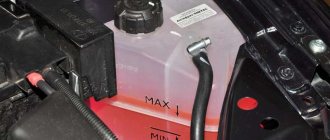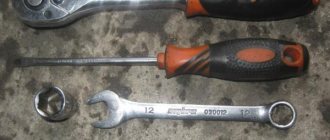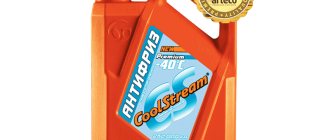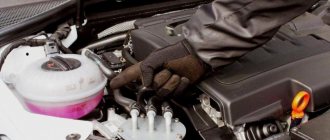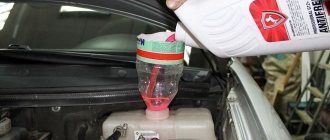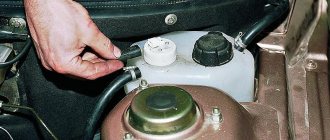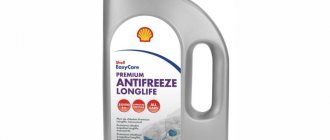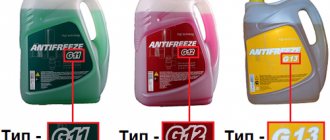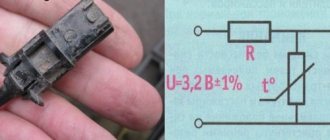Timely replacement of coolant is a procedure that many car owners neglect. And in vain. Engine performance directly depends on the cooling system. In this article we will tell you how to change antifreeze correctly with your own hands, because to change the coolant it is not at all necessary to go to a car service center.
The easiest way to replace the coolant will be if you have a garage and an inspection hole, although these are not necessary conditions. The procedure for replacing antifreeze on all cars is approximately the same:
- The old coolant must be completely drained.
- Flush the engine cooling system.
- Fill with new coolant (antifreeze or antifreeze).
At the end of the article, as always, watch the video instructions on how to replace the coolant with your own hands on a VAZ 2110 car. In the meantime, we will look at all the stages of replacing antifreeze one by one.
Why do you need antifreeze in a car?
From the name it is clear that the main task of the liquid is to cool. What exactly does the coolant have to be cooled and why?
During engine operation, a huge amount of heat is released, especially during the compression stroke, when the temperature in the cylinders reaches 2500°; without cooling, the engine would become hot in a few minutes and fail. Antifreeze also maintains the engine operating temperature, at which the highest efficiency and economy of the internal combustion engine is achieved. The “cooler” has a second advantage - it provides the car’s interior with heat when the heater is turned on, due to the circulation of the cooling system through the heating. So, antifreeze:
- cools;
- maintains optimal engine temperature;
- protects against overheating.
The principle of operation of the coolant is simple: the engine has channels called a cooling jacket. When the operating temperature is reached, the thermostat opens and the water pump supplies fluid under pressure to the engine, after which it heats up and passes through the radiator, and again enters the internal combustion engine already cooled. In addition to its main function, antifreeze provides anti-corrosion properties, eliminates the formation of scale, and has lubricating properties that are necessary for high-quality and long-term operation of the thermostat and pump.
Reasons for airing
The air that has penetrated into the system is collected into one bubble, moving through the channels to a certain place. Having reached the highest point or narrowing, it stops and blocks the flow of antifreeze (antifreeze). Practice shows that most often an air lock occurs in a large circulation circuit, including the main radiator. Although the opposite situation also happens, for example, airing of the heat exchanger of the cabin heater (in common parlance - the stove).
How air enters the cooling system of a car engine:
- the most common case is incorrect filling with antifreeze;
- due to antifreeze leaks through loose connections or faulty parts, for example, a leaky pump seal;
- due to jamming of the bypass valve built into the expansion tank plug.
The main task solved during the process of filling antifreeze is to simultaneously expel air from the cooling system. If you perform the operation in a hurry and do not follow simple rules, the formation of an air lock is guaranteed. Quick filling allows air to enter the system along with the liquid through the funnel, and then collect into one bubble.
Important point! An obvious sign of airing is a critical rise in coolant temperature at any engine operating mode.
The inclusion of an electric fan depends on the make and model of the car: if the temperature sensor is in the cylinder head, forced airflow will definitely work.
If the meter is located differently (in the main radiator, on the pipe), the fan may not start due to the sensor being in a stagnant zone. How will air get through leaks in a pressurized system, you ask? The algorithm is simple:
- During the heating process, the antifreeze increases in volume and displaces the air layer from the expansion tank through the plug valve.
- After the engine stops, the coolant cools and compresses to its previous volume, and the valve lets the air back in.
- As the antifreeze cools and contracts, leaks in the system elements will turn into sources of additional air leaks.
Similarly, airing of the cooling system occurs due to the jamming of the bypass valve. Cooling and shrinking antifreeze provokes the formation of a vacuum, which is not replenished by air flow from the outside. Then suction occurs in the weakest connections.
Types and differences of coolants
Today there are three types of coolant, each of which differs in characteristics, color, service life and composition:
- G11 is a traditional antifreeze that is widely used in domestic cars, as well as foreign cars, where the engine is designed for low loads and its operating temperature barely exceeds 90 degrees. G11 contains silicates and other substances in the form of inorganic additives. Their peculiarity is that such antifreeze provides a dense film on the surface of the cooling parts, protecting against corrosion. If the coolant is not replaced in a timely manner, the film loses its properties and turns into sediment, which reduces the throughput of the system, clogging the channels. It is recommended to change the coolant every 2 years or every 70,000 km; the same regulations apply to the “TOSOL” brand, which has similar properties;
- G12 is the name of the coolant, which is produced using organic acid (carboxylic acid) technology. This antifreeze has better thermal conductivity, but does not provide a protective film like G11. Here, corrosion inhibitors work pointwise; when corrosion occurs, they are directed to the foci, preventing the spread of rust. Over time, the cooling and anti-corrosion properties are lost, and accordingly the liquid changes color, so the regulations for the use of G12 are set for no more than 5 years or 25,00,000 km. The regulation also applies to hydride antifreeze (G12)+ and carboxylate (G12++);
- G13 is the latest generation in the world of coolants, referred to as lobrid. It differs from other brands of antifreeze in that the composition is based on propylene glycol (others have ethylene glycol). This means that G13 is more environmentally friendly and of higher quality. The main advantages of such a liquid are its ability to maintain the operating temperature of highly loaded modern engines, while the service life varies from 5 to 10 years, and is even considered “eternal” - for the entire service life.
